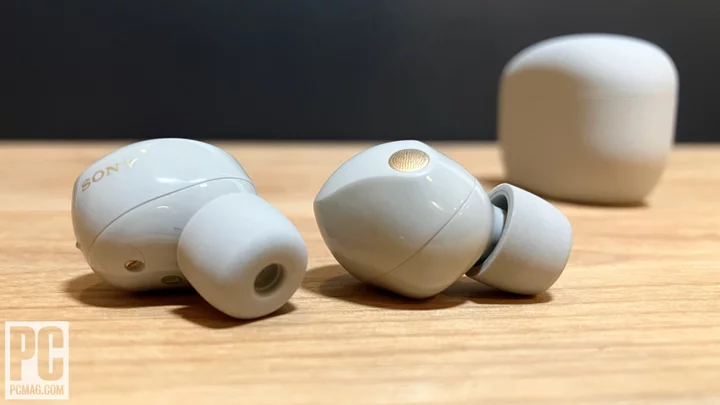When people find out I've written thousands of audio reviews for PCMag, the first thing they usually want to know is which headphones are the best. But, to me, that's like asking what type of music is best. Sure, we all have favorites, but the category is too broad to break down so simply. The real question is, what are the right headphones for you? And to answer this, you have to consider your sound preferences, desire for extra features, and, of course, budget.
With that in mind, we've gathered the absolute best headphones (and earphones) we've tested here, for a range of users and budgets. Read on for our top picks, followed by everything you need to know to find the perfect pair.
Should You Pick Earphones or Headphones?
Earbuds do not seal off the ear canal and typically offer the worst audio performance of the bunch. Earphones seal off the ear canal and therefore offer better bass response, a more balanced stereo mix, and a more secure fit.
On-ear headphones (which are also called supra-aural headphones) typically have smaller earcups that rest directly on the ear itself. Over-ear headphones (or circumaural headphones) have larger ear cups that rest around the ear.
Over-ear headphones typically provide a more immersive experience than on-ear headphones, but this isn't a rule—plenty of on-ear models sound amazing, and can even offer a little bit of passive noise isolation with the use of well-cushioned earpads. The main reasons to consider one over the other are comfort (this varies from person to person) and portability (on-ear pairs are often smaller and more travel-friendly).
How to Buy Wireless HeadphonesAre Wired or Wireless Headphones Better?
Ever since Apple eliminated the headphone jack on the iPhone, wired headphones and earphones have faded from the forefront of this category in favor of Bluetooth models that require no cable at all. And true wireless headphones don't even have a wire connecting the two earpieces.
Audiophiles probably still prefer a cable, particularly for home listening (small cable adapters are available for Android and iOS devices with no headphone jack). If you prefer wired headphones, there are still lots of options available, but it's also worth noting that plenty of wireless headphones come with a cable that lets you use them in a passive mode. That use case doesn't drain the battery and gives you the best of both worlds.
The sonic advantage of wired headphones is still quite significant, even if Bluetooth audio has improved dramatically in recent years. No matter how much better Bluetooth has gotten, it is still based on a lossy codec stream, making it inherently inferior to a wired audio connection. If sonics are important to you and you want to go wireless, make sure your headphones have the right high-end Bluetooth codecs that work with your phone, like LDAC and AAC, and don't simply use the lower-quality SBC codec. Our guide to Bluetooth codecs explains everything you need to know.
Bose QuietComfort Ultra Headphones (Credit: Tim Gideon)What Are the Different Types of Headphone Drivers?
Headphones most typically have dynamic drivers, whereas earphones might have dynamic drivers or balanced armature drivers. Especially in headphones, dynamic drivers are the most common, because a larger dynamic driver—which the ear enclosure for a pair of headphones can accommodate—can get louder and produce more bass depth. In earphones, the dynamic drivers have to be much smaller; this can often affect bass response.
Many manufacturers, especially those in the business of making custom-molded in-ear monitors for musicians and engineers, turn to balanced armature drivers instead. Balanced armatures have the advantage of being tiny, which allows the earpieces to be smaller. Or, in the case of the aforementioned custom in-ear monitors, the earpieces can be quite large—freeing up room internally for several balanced armatures per ear, with each driver handling a specific frequency range. Generally speaking, it's possible to get excellent audio—or poor audio—from both dynamic and balanced armature drivers, although the two styles have dedicated fan bases.
In both headphones and earphones, the planar magnetic driver continues to gain ground slowly. Headphones with these drivers are typically (much) more expensive. But the advantage of planar magnetic drivers is that they, ostensibly, produce a more precise sound because of the flat, larger-than-a-dynamic-driver film that vibrates between two magnets to create sound.
Electrostatic speakers and headphones are similar to planar magnetic models in that they use a large, thin surface area to deliver the audio. But we see far fewer electrostatic headphones than any other type—they are typically through-the-roof expensive and best for home use.
What Is Active Noise Cancellation?
Noise cancellation used to be one of the most expensive features you could find in headphones, but it's now mainstream in both the headphone and earphone realms. Not only that, but the shift from wired to wireless headphones in terms of popularity has meant that most of the active noise cancellation (ANC) pairs we see are now wireless.
That's excellent for convenience, but never assume that all ANC is the same. Simply put, the best of the ANC realm is quite effective, with Bose leading the category, but plenty of other manufacturers from Apple to Sony offer top-notch options. See how we test noise cancellation to understand how it works and how we test this feature.
When ANC goes wrong, there are three main ways to tell. One, it's just not very effective—it doesn't tamp down low-frequency rumble as it should, or the overall reduction in surrounding noise isn't profound enough to make it compelling. Two, the ANC circuitry creates a faint hiss—not necessarily unpleasant, but certainly audible (similar to white noise or tape hiss). This is often to mask the fact that the ANC circuitry can't effectively remove some higher-frequency sounds. Third, lower-quality, wireless headphones often have ANC modes that affect the sound signature.
AirPods Pro (2nd Generation) (Credit: Tim Gideon)When we describe headphones with excellent noise cancellation, it's more or less the opposite. They squash the low frequencies effectively, tamp down surrounding chatter and common environmental noises, and don't produce much of a high-frequency hiss (if any). The sound signature also shouldn't sound wildly different when this mode is active. Beyond that, several manufacturers, like Bose, offer apps that let you adjust the intensity of the noise cancellation mode.
An increasing number of noise-cancelling headphones now include mics that power ambient listening modes. The point is to allow you to hear your surroundings as if you didn't have your headphones on, so you can talk to others without removing them. It's become a popular-enough feature that plenty of non-ANC pairs now have this feature too. Apple's Adaptive Audio mode is one of the best implementations.
For more, see the best noise-cancelling true wireless earbuds and the best headphones for your home office.
4 ways you're using your headphones totally wrong — Clarification PleaseWhat Are the Best Headphones for Exercise?
Aside from sometimes offering ambient mics for hearing your surroundings, exercise-focused headphones and earphones typically offer water-resistant builds and extra in-ear fit security accessories.
The most important feature of any exercise-focused headphones remains the IP rating. IP stands for ingress protection, and you often see ratings such as IPX7 or IP65. The first number represents protection against solids like dust (X acts as a placeholder, usually because the manufacturer didn't officially test against dust or solids), while the second number describes protection against fluids like water and sweat. For more, see our guide to IP ratings.
As mentioned, another consideration is in-ear fit. We all have different ears, and some earphones fit better than others. If you've had trouble getting in-ears to stay in place in the past, consider a pair that comes with multiple eartips or earfins that sit against the ear to help add stability. It's also worth considering foam eartips (which sometimes ship with earphones, but are less common than silicone) because they expand in the canal to create a stronger seal, much like earplugs. They also often have the benefit of increasing the bass response.
For more, see our picks for the best true wireless earbuds for running.
Do Headphones Work With Voice Assistants?
Most wireless headphones now include a button or action that summons your phone's built-in voice assistant. But the next frontier is headphones that are always listening, like smart speakers. Many headphones can summon your smartphone's built-in voice assistant with a wake word or phrase (like "Hey Siri" or "Alexa") while others require a button press.
How Much Should You Spend on Headphones?
Quality and performance can certainly cost money, though that isn't always the case and they aren't the only factors that dictate the price of headphones. Currently, certain technologies—active noise cancellation and spatial audio are the two most obvious examples—tend to drive up the price. That doesn't mean you can't find affordable true wireless earphones, but the higher-quality options tend to kick in around $150, while most excellent noise-cancelling headphones start around $300. Iconic branding—think Apple, Beats, and Bose, to name a few—also impact pricing.
In short, you can pay as little as $50 for good earphones or headphones and several hundred dollars 000 for audiophile models. Generally speaking, we see most quality options fall in the range between $100 and $400. Plenty of strong in-ear, over-ear, and on-ear models are available in the $100 to $200 bracket, however.
Once you find the pair that's right for you, make sure to take good care of them with our five easy tips to extend the life of your headphones. We also have an article on the eight ways you're using your headphones wrong.









